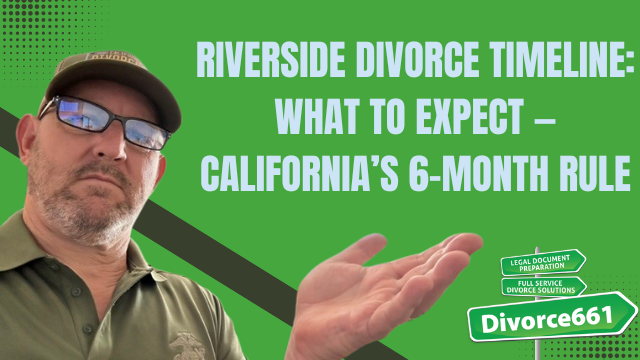Riverside Divorce Timeline: What to Expect — California’s 6-Month Rule
I’m Tim Blankenship from Divorce661. If you’re starting a divorce in Riverside County (or anywhere in California), the single most important timeline to understand is the state-mandated six-month waiting period. In this article I’ll walk you through what starts that clock, the key steps to finish your case efficiently, why delays happen, and how to avoid them so your divorce can move as smoothly and quickly as possible.
What the Six-Month Waiting Period Actually Means
California mandates a six-month waiting period for divorces.
That six-month clock begins the moment your spouse is properly served with the divorce papers. It’s a minimum: the court cannot enter a final judgment dissolving the marriage until at least six months have passed from service. That doesn’t mean you can’t complete most of the paperwork and agreements earlier — you absolutely can and should — but finalization cannot occur before the statutory waiting period expires.
Step-by-step Riverside Divorce Timeline
- File the initial paperwork. Start by filing the Petition for Dissolution, Summons, and — if you have children and jurisdiction issues to consider — the UCCJEA (child custody jurisdiction) form as required.
- Properly serve your spouse. Correct service is essential. Personal service (or other legally recognized service methods) triggers the six-month waiting period. Mistakes in service create delays.
- Exchange mandatory financial disclosures. California requires full financial transparency: typically a Declaration of Disclosure (including schedules of assets and debts), income and expense information, and supporting documents. Exchanging these early prevents surprises and keeps your case moving.
- Negotiate and sign a Marital Settlement Agreement. For amicable cases, negotiate division of property, debt allocation, spousal support (if any), and child-related arrangements. Once both parties sign, this becomes the basis for the final judgment.
- File the final judgment and supporting documents for court review. Submit your signed settlement agreement and required forms to the court. If everything is complete and correct, the court can review and approve your judgment without a hearing.
- Finalization. The court may approve the judgment and enter the final decree once the six-month period has elapsed and all documents are in order. With good preparation, there are often no court appearances required.
What to File and When
- Petition for Dissolution and Summons — file at the outset.
- UCCJEA (child custody jurisdiction) — file if you and/or children have ties to other states.
- Preliminary and final Declarations of Disclosure — exchanged early to avoid delays.
- Marital Settlement Agreement and Judgment packet — filed when both parties agree.
Why Delays Happen — and How to Avoid Them
- Improper service: If service is defective, the six-month clock may not start. Use a professional server or follow the court rules exactly.
- Incomplete or incorrect forms: Missing signatures, incorrect dates, or omitted attachments can push your case back into review.
- Late or incomplete disclosures: Failing to provide full financial disclosures invites challenges and slows approval.
- Contested issues: If parties disagree on custody, property division, or support, those disputes extend the timeline.
To avoid delays: prepare forms carefully, exchange disclosures promptly, communicate clearly, and get professional help on paperwork and filing procedures when needed.
A Real Riverside Example: Fast, Efficient, Remote
We worked with a Riverside couple who completed all of their paperwork in 30 days. Because everything was prepared accurately and served properly, their judgment was approved swiftly, and the divorce was finalized on time — all without any in-person court appearances. This kind of efficiency comes from planning, attention to detail, and following the required steps in the correct order.
How Divorce661 Helps
At Divorce661 we provide a full-service solution for amicable divorces in California. We handle filing, service guidance, disclosure facilitation, document preparation, and filing the final judgment — often on a fast, flat-fee basis. Our service is 100% remote, which means no courtroom appearances and fewer opportunities for avoidable delays.
If you want help keeping your Riverside divorce on track, schedule a free consultation at https://divorce661.com or book a consultation directly at https://divorce661.com/divorce661-consultation/.
Key Takeaways
- The six-month waiting period is mandatory and begins when your spouse is properly served.
- You can (and should) complete filings, disclosures, and settlement negotiations well before six months pass.
- Proper service, accurate paperwork, and timely disclosures are the top factors that keep a divorce moving quickly.
- With careful planning and the right support, many uncontested divorces can be handled remotely and finalized without court appearances.
If you have questions about the Riverside divorce timeline or want help moving your case forward efficiently, I’m here to help.

